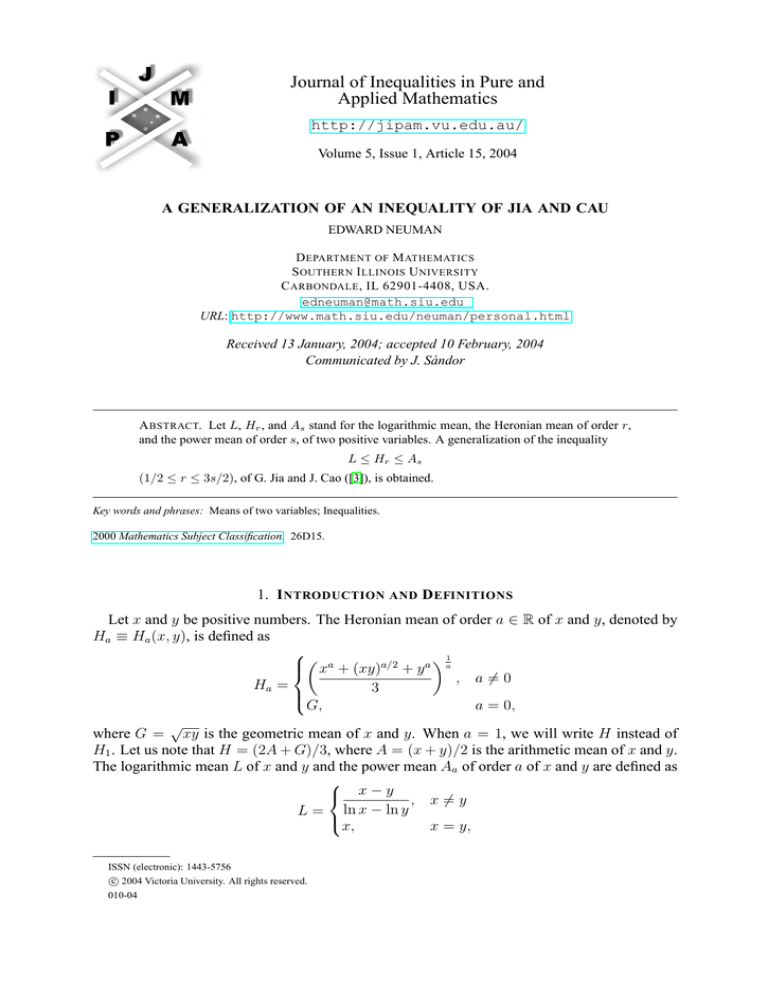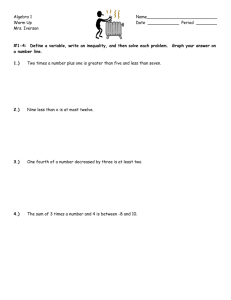
Journal of Inequalities in Pure and
Applied Mathematics
http://jipam.vu.edu.au/
Volume 5, Issue 1, Article 15, 2004
A GENERALIZATION OF AN INEQUALITY OF JIA AND CAU
EDWARD NEUMAN
D EPARTMENT OF M ATHEMATICS
S OUTHERN I LLINOIS U NIVERSITY
C ARBONDALE , IL 62901-4408, USA.
edneuman@math.siu.edu
URL: http://www.math.siu.edu/neuman/personal.html
Received 13 January, 2004; accepted 10 February, 2004
Communicated by J. Sándor
A BSTRACT. Let L, Hr , and As stand for the logarithmic mean, the Heronian mean of order r,
and the power mean of order s, of two positive variables. A generalization of the inequality
L ≤ Hr ≤ As
(1/2 ≤ r ≤ 3s/2), of G. Jia and J. Cao ([3]), is obtained.
Key words and phrases: Means of two variables; Inequalities.
2000 Mathematics Subject Classification. 26D15.
1. I NTRODUCTION AND D EFINITIONS
Let x and y be positive numbers. The Heronian mean of order a ∈ R of x and y, denoted by
Ha ≡ Ha (x, y), is defined as
1
xa + (xy)a/2 + y a a
, a 6= 0
Ha =
3
G,
a = 0,
√
where G = xy is the geometric mean of x and y. When a = 1, we will write H instead of
H1 . Let us note that H = (2A + G)/3, where A = (x + y)/2 is the arithmetic mean of x and y.
The logarithmic mean L of x and y and the power mean Aa of order a of x and y are defined as
x − y , x 6= y
L = ln x − ln y
x,
x = y,
ISSN (electronic): 1443-5756
c 2004 Victoria University. All rights reserved.
010-04
2
E DWARD N EUMAN
and
1
xa + y a a
,
Aa =
2
G,
a 6= 0
a = 0,
respectively. Throughout the sequel the means of order one will be denoted by a single letter
with the subscript 1 being omitted.
In the recent paper [3] the authors have established the following result. Let 12 ≤ r ≤ 32 s.
Then
L ≤ H r ≤ As .
(1.1)
All the means mentioned earlier in this section belong to the large family of means introduced
by K.B. Stolarsky in [8]. This two-parameter class of means, denoted by Da,b , is defined as
follows
1
b xa − y a (a−b)
·
,
ab(a − b) 6= 0
a xb − y b
a
a
exp − 1 + x ln x − y ln y , a = b 6= 0
a
xa − y a
(1.2)
Da,b =
a1
xa − y a
,
a 6= 0, b = 0
a(ln
x
−
ln
y)
G,
a = b = 0.
For later use let us record some formulas which follow from (1.2). We have
(1.3)
Hr = D3r/2,r/2 , As = D2s,s , Lp = Dp,0 , It = Dt,t .
Here Lp is the logarithmic mean of order p and It is called the identric mean of order t.
The inequalities (1.1) can be written in terms of the Stolarsky means as
(1.10 )
D1,0 ≤ D3r/2,r/2 ≤ D2s,s .
The goal of this note is to provide a short proof of a general inequality (see (2.1)) which
contains (1.1) as a special case.
2. M AIN R ESULT
For the reader’s convenience, we recall the Comparison Theorem for the Stolarsky means.
Two functions
|p| − |q| , p 6= q
k(p, q) =
p−q
sign(p),
p=q
and
(
L(p, q), p > 0, q > 0
l(p, q) =
0,
p·q =0
play a crucial role in the Comparison Theorem which has been established by E.B. Leach and
M.C. Sholander [4] and also by Zs. Páles [6].
Theorem 2.1 (Comparison Theorem). Let a, b, c, d ∈ R. Then the comparison inequality
Da,b ≤ Dc,d
J. Inequal. Pure and Appl. Math., 5(1) Art. 15, 2004
http://jipam.vu.edu.au/
A G ENERALIZATION O F A N I NEQUALITY O F J IA A ND C AU
3
holds true if and only if a + b ≤ c + d and
l(a, b) ≤ l(c, d)
if 0 ≤ min(a, b, c, d),
k(a, b) ≤ k(c, d)
if min(a, b, c, d) < 0 < max(a, b, c, d),
−l(−a, −b) ≤ −l(−c, −d)
if max(a, b, c, d) ≤ 0.
In what follows the symbols R+ and R− will stand for the nonnegative semi-axis and the
nonpositive semi-axis, respectively.
The main result of this note reads as follows.
Theorem 2.2. Let p, q, r, s, t ∈ R+ . Then the inequalities
(2.1)
Dp,q ≤ Hr ≤ Ds,t
hold true if and only if
s+t
p+q
(2.2)
max
, (ln 3)l(p, q) ≤ r ≤ min
, (ln 3)l(s, t) .
2
2
If p, q, r, s, t ∈ R− , then the inequalities (2.1) are reversed if and only if
s+t
p+q
(2.3)
max
, (− ln 3)l(−s, −t) ≤ r ≤ min
, (− ln 3)l(−p, −q) .
2
2
Proof. We shall establish the first part of the assertion only. Using the Comparison Theorem
we see that the inequalities
(2.4)
Dp,q ≤ D3r/2,r/2 ≤ Ds,t
hold true if and only if
(2.5)
p + q ≤ 2r ≤ s + t
and
r
≤ l(s, t).
ln 3
Solving the inequalities for r we obtain (2.2). Since the middle term in (2.4) equals to Hr (see
(1.3)), the assertion follows.
(2.6)
l(p, q) ≤
Remark 2.3. Letting p = 1, q = 0, s := 2s and t = s in (2.1) and next using (1.10 ) we obtain
the inequalities (1.1).
Corollary 2.4. Let p, q, r, s, t ∈ R+ . Then the inequalities
(2.7)
Lp ≤ Hr ≤ As ≤ It
hold true if and only if p ≤ 2r ≤ 3s ≤ 2t.
Proof. Letting q = 0, s := 2s, and t = s in (2.1) and (2.2) we obtain the first two inequalities
in (2.7). It is easy to see, using the Comparison Theorem, that the inequality D2s,s ≤ Dt,t is
valid if and only if 3s ≤ 2t. This completes the proof of the third inequality in (2.7) because of
(1.3).
√
It is worth mentioning that (2.7) contains two known results: H ≤ I (see [7]) and AL ≤
A2/3 ≤ I (see [5]). Indeed, letting p = 2, r = 1, s = 32 and t = 1 in Corollary 2.4 we obtain
√
(2.8)
AL ≤ H ≤ A2/3 ≤ I.
√
Here we have used the formula L2 = AL.
J. Inequal. Pure and Appl. Math., 5(1) Art. 15, 2004
http://jipam.vu.edu.au/
4
E DWARD N EUMAN
The celebrated Gauss’ arithmetic-geometric mean AGM ≡ AGM (x, y) of x > 0 and y > 0
∞
is the common limit of two sequences {xn }∞
0 and {yn }0 , i.e.,
AGM = lim xn = lim yn ,
n→∞
n→∞
√
where x0 = x, y0 = y, xn+1 = (xn + yn )/2, yn+1 = xn yn (n ≥ 0). This important mean is
used for numerical evaluation of the complete elliptic integral of the first kind [2]
Z
2 π/2 2
2 2
RK (x , y ) =
(x cos2 φ + y 2 sin2 φ)−1/2 dφ.
π 0
Gauss’ famous result states that RK (x2 , y 2 ) = 1/AGM (x, y).
Corollary 2.5. Let x > 0 and y > 0. Then
(2.9)
AGM ≤ H3/4 .
Proof. J. Borwein and P. Borwein [1, Prop. 2.7] have proven that AGM ≤ L3/2 . On the other
hand, using the first inequality in (2.7) with p = 3/2 and r = 3/4 we obtain L3/2 ≤ H3/4 .
Hence (2.9) follows.
Some results of this note can be used to obtain inequalities involving hyperbolic functions.
For instance, using (2.7), (1.3), and (1.2), with x = e and y = e−1 , we obtain
1 1
1
sinh p p
2 cosh r + 1 r
1
≤
≤ (cosh s) s ≤ exp − + coth t
p
3
t
(0 < p ≤ 2r ≤ 3s ≤ 2t).
R EFERENCES
[1] J.M. BORWEIN AND P.B. BORWEIN, Inequalities for compound mean iterations with logarithmic
asymptotes, J. Math. Anal. Appl., 177 (1993), 572–582.
[2] B.C. CARLSON, Special Functions of Applied Mathematics, Academic Press, New York, 1977.
[3] G. JIA AND J. CAO, A new upper bound of the logarithmic mean, J. Ineq. Pure and Appl. Math.
4(4) (2003), Article 80. [ONLINE: http://jipam.vu.edu.au].
[4] E.B. LEACH AND M.C. SHOLANDER, Multi-variable extended mean values, J. Math. Anal. Appl.,
104 (1984), 390–407.
[5] E. NEUMAN AND J. SÁNDOR, Inequalities involving Stolarsky and Gini means, Math. Pannonica,
14(1) (2003), 29–44.
[6] Zs. PÁLES, Inequalities for differences of powers, J. Math. Anal. Appl., 131 (1988), 271–281.
[7] J. SÁNDOR, A note on some inequalities for means, Arch. Math. (Basel), 56(5) (1991), 471–473.
[8] K.B. STOLARSKY, Generalizations of the logarithmic mean, Math. Mag., 48(2) (1975), 87–92.
J. Inequal. Pure and Appl. Math., 5(1) Art. 15, 2004
http://jipam.vu.edu.au/






